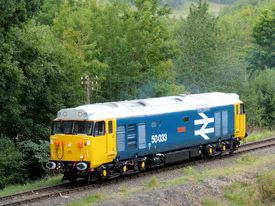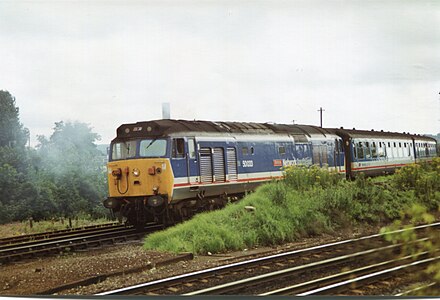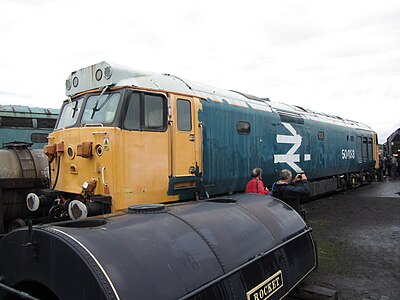BR Class 50 50033 Glorious
| BRBritish Rail or British Railways Class 50 50033 Glorious | |
|---|---|
 50033 Glorious | |
| Built By | English Electric Vulcan Foundry Works, Newton-le-Willows |
| Configuration | Co-Co |
| Power type | Diesel Electric |
| Loco Number | 50033 |
| Other Numbers | D4336 |
| History | |
| Built | 1968 |
| Designed By | English Electric |
| Type | Class 50 |
| 1994 | Withdrawn |
| 2004 | Last working at NYMR |
| 2018 | Returned to traffic at SVRSevern Valley Railway |
| Technical | |
| Length | 68ft 6" |
| Weight | 115t |
BRBritish Rail or British Railways Class 50 50033 Glorious is on loan to The Class 50 Alliance.
BRBritish Rail or British Railways Class 50
Fifty English Electric Type 4The British Railways classification for diesel locomotives of 2000 bhp to 2999 bhp (later BRBritish Rail or British Railways Class 50) diesel locomotives were built by English Electric at their Vulcan Foundry Works plant in Newton-le-Willows between 1967 and 1968. When built they were numbered in the D4xx series. They later became BRBritish Rail or British Railways’s Class 50, being allocated TOPS numbers in the 50xxx series. The class was nicknamed “Hoovers” because of the distinctive sound of the inertial air-filters with which the locomotives were originally fitted.
Initially the locomotives were used to haul express passenger trains on the West Coast Main Line (WCML) between Crewe and Scotland; that section not then being electrified. This often entailed ‘Multiple Working’, with two locomotives under control of a single driver.
By 1974 the northern WCML had been electrified, and the Class 50 fleet was being transferred to BRBritish Rail or British Railways’s Western Region to work main line passenger services out of London Paddington.
The Class 50s did not originally carry names, but in the late 1970s BRBritish Rail or British Railways agreed to their being named after Royal Navy vessels with notable records in the First and Second World Wars.
Withdrawal of the class began in the early 1990s.
50033 Glorious in service
D449 entered service at Stoke in July 1968. While operating a passenger service on 9 July 1970 it suffered minor damage from a fire caused by leaking fuel or lubricating oil.[1]
Renumbered to 50049 in January 1973, the locomotive moved to Bristol in May 1974 and Plymouth Laira in October 1976. It received the name 'Glorious' at Laira in June 1978[1] after HMS Glorious, a First World War Courageous-class battlecruiser later converted to an aircraft carrier and sunk by the German battleships Scharnhorst and Gneisenau while evacuating British aircraft from Norway in June 1940.
During 1990, Old Oak Common depot painted 50033 Glorious in NSE livery, leaving the nameplates in their original position, so that the result read "Glorious Network SouthEast".[2]
The locomotive's last day of BRBritish Rail or British Railways working was the "Cornish Caper Railtour"[3] on 19 March 1994 which also featured 50007 Hercules and 50050 Fearless.
50033 Glorious in preservation
After working the Cornish Caper Railtour, 50033 was withdrawn from BRBritish Rail or British Railways service and delivered to the National Railway Museum in York as part of the national collection.
The NRMThe Railway Museum, formerly the National Railway Museum decided to dispose of the locomotive in 2003, subject to a suitable home being found, due to their inability to commit to future maintenance and storage costs. While still owned by the NRMThe Railway Museum, formerly the National Railway Museum, 50033 spent a period on loan to the North Yorkshire Moors Railway during 2004, after which a home was found at the STEAM museum in Swindon as a static exhibit.
A plan for 50033 to relocate to 'RailSchool' at the Royal Docks Heritage Railway in East London was unsuccessful and for many years the locomotive was stored in an unserviceable condition at the Birmingham Railway Museum at Tyseley.[4]
In February 2018 an agreement was reached with owners Tyseley Locomotive Works[5] for The Class 50 Alliance to take 50033 on a 3 year loan with a view to restoring the loco and getting it operational.[6] Work on the locomotive continued at Tyseley under the guidance of Fifty Fund volunteers[7] before the locomotive moved to the Diesel Depot on 31 May 2018.[8] The locomotive returned to traffic at the Class 50 Golden Jubilee on 4-6 October 2018 in mostly green undercoat, with the public invited to 'tag' the locomotive with graffiti in marker pen in exchange for a contribution towards its repaint. Repainting in BRBritish Rail or British Railways 'Large Logo' livery took place at Arlington in Eastleigh, effectively returning the locomotive to the same cosmetic condition in which it was withdrawn,[3] after which it was towed back to the SVRSevern Valley Railway by sister 50007 Hercules on 29 August 2019,[9] appearing in its new livery at the October 2019 Diesel gala.
The Alliance took the runner up prize at the HRA Awards 2020 in the Coiley Locomotive Engineering Award category for this restoration.[10] After the initial loan period expired the locomotive remained at the SVRSevern Valley Railway on long term loan to the Alliance.[11]
In June 2021 the 33-ton power unit was removed to allow the main generator to be replaced by an overhauled unit. In spring 2022 the internal bodywork was thoroughly cleaned and repainted prior to the engine-end being overhauled and main and auxiliary generators refitted.[12] It returned to traffic on 24 September 2022 at an event to commemorate the 30th anniversary of the first Class 50 to haul a public passenger train in preservation.
See also
References
- ↑ 1.0 1.1 BR Database
- ↑ BR Class 50 on Wikipedia
- ↑ 3.0 3.1 Fifty Fund, 50033
- ↑ EnglishElectric.org.uk, 50033
- ↑ SVRSevern Valley Railway News 206, Diesel Update, Jonathan Dunster
- ↑ Fifty Fund
- ↑ Fifty Fund website (Retrieved 11 February 2018)
- ↑ Railway Magazine
- ↑ SVR Live
- ↑ Severn Valley Diesels Official Facebook, 11 February 2020
- ↑ Railways Illustrated, October 2022
- ↑ SVRSevern Valley Railway News 217
Links
| ||||||||||||||||||||||||||||||||||||||||||||||||||||||||||||||||||||||||



